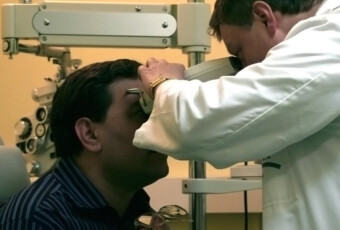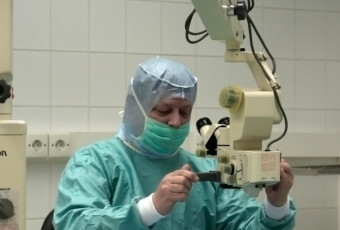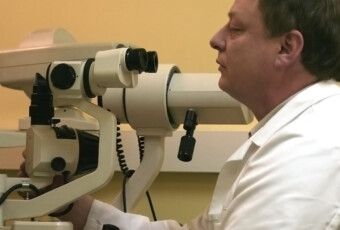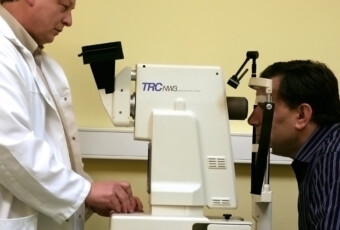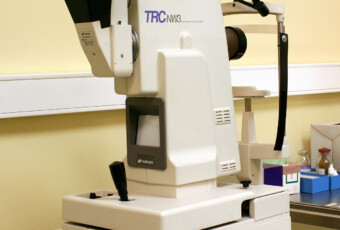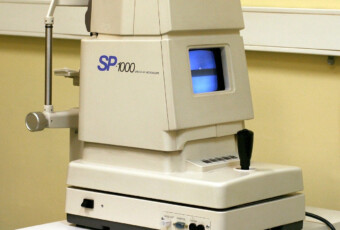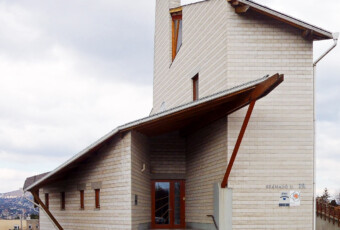Artsybashev Keratoconus Center is a specialized medical center that treats keratoconus using diamond surgery. This center was opened in 1994 in Budapest by a well-known ophthalmic surgeon, academician Sergei Artsybashev, who developed a unique surgical technique for the treatment of keratoconus at all stages of the disease. Dr. Artsybashev's method allows patients to preserve their own cornea, stop the progression of keratoconus, and avoid transplantation surgery, as well as improve vision.
With the help of diamond surgery, keratoconus can be cured after ineffective corneal crosslinking and implantation of stromal rings or segments and also apply for the same purpose after laser vision correction (LASIK, LASEK, PRK, PTK).
In Artsybashev Keratoconus Center, keratoconus has been treating in patients from different countries for more than 25 years. A lot of experience in diamond surgery has been accumulated. Short-term and long-term (more than 20 years) results indicate the effectiveness of the method.
Doctor Artsybashev and his unique method of treating keratoconus
Academician Artsybashev is the only ophthalmic surgeon who owns the method of diamond surgery and has 30 years of experience in its application. He has performed over 1,000 successful surgeries for stage I-IV keratoconus, including those with central corneal opacity.
Academician Artsybashev developed the method of diamond surgery based on his many years of experience in corneal surgery. He has performed more than 30 thousand successful surgical interventions to correct the optical functions of the cornea in myopia and astigmatism, including on ultra-thin and deformed corneas. These experience and qualifications allowed him to develop and implement his own unique method of corneal surgery for keratoconus.
Diamond Surgery at Artsybashev Keratoconus Center
The “diamond surgery” technique (radial keratotomy) consists in applying from 3 to 12 notches to the cornea using a diamond scalpel. The ophthalmic surgeon determines the depth and location individually for each patient. Healing and scarring of these micro-incisions are curative and corrective:
- pathological protrusion (cone) of the cornea is eliminated;
- thinning is reduced and transparency is improved;
- there is a decrease in the impact of intraocular pressure from the thinned part of the cornea to a healthier one;
- dryness of the cornea is eliminated due to the correct distribution of tears over the entire surface of the cornea;
- during the rehabilitation period, collagen and a framework of thin scars are formed, which strengthen and stabilize the cornea;
- the optical functions of the cornea (visual acuity) are improved.
Diamond surgery for keratoconus makes it possible to correct and stabilize the shape of the cornea in one procedure with the help of individual corneal remodeling for each eye. It also improves visual acuity. After the operation, patients do not need to wear glasses and hard contact lenses.
How is diamond surgery performed by Doctor Artsybashev
Diamond surgery is a one-day eye microsurgery. Dr. Artsybashev plans each surgical intervention taking into account the individual characteristics of the shape of the cornea and careful calculations. Before the operation, he conducts an appropriate examination.
The ophthalmic surgeon performs the procedure on an outpatient basis, under local anesthesia with eye drops, for 2-3 minutes on each eye. On the peripheral zone of the convex and thinned cornea, Dr. Artsybashev makes micro-incisions under a microscope using a special diamond scalpel. This ultra-thin unique instrument is made in Switzerland. Dr. Artsybashev operates with both hands, which is technically necessary for this type of intervention. He makes notches with a diamond knife on one half of the cornea with one hand and on the other half with the other.
Rehabilitation and results after diamond surgery with Artsybashev
Corneal healing after gentle microsurgery is very fast. Improvement in vision is usually felt by patients the next day after surgery. The rehabilitation period, during which the improvement of vision continues to its possible maximum level and stabilization, can last from 6 months to 2 years, depending on the stage of the disease.
Doctor Artsybashev developed and implemented a technique for the postoperative rehabilitation of patients. It contributes to better scarring of micro-incisions, the maximum improvement in vision, and stabilization of the cornea during the rehabilitation period.
It is possible to organize the treatment of keratoconus with Doctor Artsybashev with the help of Experts Medical. To do this, you need to leave an application for treatment at the Artsybashev Keratoconus Center on the website for coordinators-doctors.
Ophtalmology
Surgery

| Ophtalmology examination | 100 EUR | Enquire price |
| Diamond surgery for the treatment of keratoconus in 1 eye | 5000 - 10 000 EUR | Enquire price |
He opened his own ophthalmological clinic in Budapest, registered in the EU as the Artsybashev Keratoconus Center.
In May 2007, Dr. Artsybashev became a full member of the Ukrainian Academy of Sciences.
Check the cost of treatment and get 20 000 € from international foundation
Get financial help up to 20 000 € for your child treatment
Medical consultant
Turkish oncologist will provide an individual chemotherapy program.
Israeli oncologist will provide an individual chemotherapy program.
Spanish oncologist will provide an individual chemotherapy program.
German oncologist will prepare an individual chemotherapy program.
Polish oncologist will prepare an individual chemotherapy program.
Italian oncologist will prepare an individual chemotherapy program.
Turkish radiologist will prepare a personalized radiation therapy program
Israeli radiologist will draw up an individual radiation therapy program.
German radiologist will draw up an individual radiation therapy program.
Spanish radiologist will draw up an individual radiation therapy program.
Polish radiologist will prepare an individual radiation therapy program.
Italian radiologist will draw up an individual radiation therapy program.
Turkish plastic surgeon will make an individual operation program.
German plastic surgeon will make an individual operation program.
Israeli plastic surgeon will make an individual operation program.
Italian plastic surgeon will make an individual operation program.
Polish plastic surgeon will make an individual operation program.
Spanish plastic surgeon will make an individual operation program.
Turkish orthopedic surgeon will make an individual operation program.
Israeli orthopedic surgeon will make an individual operation program.
German orthopedic surgeon will make an individual operation program.
Italian orthopedic surgeon will make an individual operation program.
Lithuanian orthopedic surgeon will make an individual operation program.
Polish orthopedic surgeon will make an individual operation program.
Ukrainian orthopedic surgeon will make an individual operation program.
Spanish orthopedic surgeon will make an individual operation program.
Turkish neurosurgeon will study the medical situation and give recommendations for treatment.
Israeli neurosurgeon will study the medical situation and give recommendations for treatment.
German neurosurgeon will study the medical situation and give recommendations for treatment.
Italian neurosurgeon will study the medical situation and give recommendations for treatment.
Lithuanian neurosurgeon will study the medical situation and give recommendations for treatment.
Spanish neurosurgeon will study the medical situation and give recommendations for treatment.
Ukrainian neurosurgeon will study the medical situation and give recommendations for treatment.
Turksih doctor will answer your questions
Israeli doctor will answer your questions
German doctor will answer your questions
Italian doctor will answer your questions
Polish doctor will answer your questions
Ukrainian doctor will answer your questions
Spanish doctor will answer your questions
Israeli orthopedic surgeon prepare an individual surgical plan and recomendations
Turkish orthopedic surgeon prepare an individual surgical plan and recomendations
German orthopedic surgeon prepare an individual surgical plan and recomendations
Italian orthopedic surgeon prepare an individual surgical plan and recomendations
Lithuanian orthopedic surgeon prepare an individual surgical plan and recomendations
Polish orthopedic surgeon prepare an individual surgical plan and recomendations
Spanish orthopedic surgeon prepare an individual surgical plan and recomendations
Lithuanian doctor will answer your questions
After examining your situation, doctor will make an individual price offer.
Doctor-consultant will answer all your questions about the cost of treatment, the choice of a doctor and fully organize treatment abroad.

we will contact you within 15 minutes
Keratoconus is a progressive non-inflammatory disease of the cornea, in which the cornea becomes cone-shaped, more prominent, and thinner. The main problem of the keratoconus is a pathological change in the shape of the thinned cornea.
Keratoconus proceeds individually in each eye and is unpredictable in its rate of progression. The development of the cone, depending on its location, does not always lead to visual impairment. Therefore, sometimes it can be detected only in the later stages of the disease.
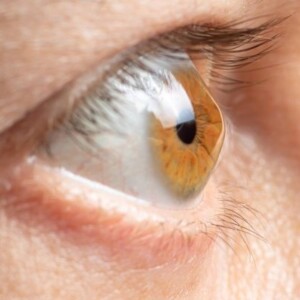 By origin, keratoconus can be primary and secondary.
By origin, keratoconus can be primary and secondary.
In primary keratoconus, it is not possible to identify a specific cause of its occurrence, but several factors may play a role:
- heredity;
- reduced immunity;
- diseases of the endocrine system;
- stress;
- environmental influence.
The process is chronic, which leads to damage to both eyes.
Causes of secondary keratoconus can be:
- artificial thinning of the cornea as a result of medical interventions;
- infections (bacteria, viruses, fungi, parasites);
- inflammation;
- trauma;
- eye rubbing.
The process is often acute and one-sided.
Currently, Dr. Artsybashev is the only eye surgeon who is skilled in diamond surgery with 30 years of experience in its application. More than 1,000 patients at various stages of the disease have been successfully operated on at the Artsybashev Center.
Dr. Artsybashev has performed more than 30,000 successful refractive surgeries to correct the visual functions of the cornea in myopia and astigmatism, including operations on thinned corneas. This is what helped him develop the method of diamond surgery and implement it for the treatment of keratoconus.
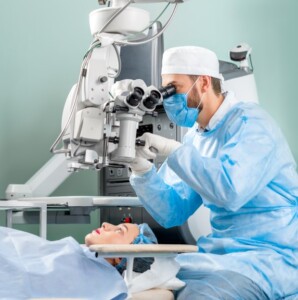 The main principle of Dr. Artsybashev is the redistribution of the increased effect of intraocular pressure from the thinned part of the cornea to a healthier one.
The main principle of Dr. Artsybashev is the redistribution of the increased effect of intraocular pressure from the thinned part of the cornea to a healthier one.
Due to the cone, the cornea lacks the tears necessary to nourish its anterior layers in the pathology zone, so patients complain of feeling of dry eyes. The flattening of the cone achieved by Dr. Artsybashev helps to improve trophic innervation and the correct distribution of tears over the entire surface of the cornea.
After micro-incisions specially selected for each patient are applied to the cornea, its shape and thickness are improved in the right place. As a result of the redistribution of pressure, the corneal tissue becomes capable of partial or complete restoration of its functions, including visual ones.
During the rehabilitation period, the cornea is strengthened and thickened by the formation of new collagen. The resulting thin scars of micro-incisions perform a frame function, that is, they contribute to the stable strengthening of the cornea and stop the thinning process.
Dr. Artsybashev developed a technique for the postoperative management of patients. This contributes to better scarring of micro-incisions, the maximum improvement in vision, and stabilization of the cornea in a minimum period of rehabilitation.
Patients experience improvement in vision the next day after surgery. The rehabilitation period, during which the restoration and stabilization of vision to the maximum level take place, can last from 6 months to 2 years, depending on the severity of the disease. In this case, it is necessary to follow medical recommendations.
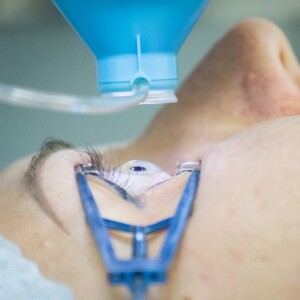 On the peripheral zone of the convex and thinned cornea under a microscope, individual micro-cuts are applied using a micrometric diamond knife. Dr. Artsybashev operates with individual instruments, which are made in Switzerland on special order.
On the peripheral zone of the convex and thinned cornea under a microscope, individual micro-cuts are applied using a micrometric diamond knife. Dr. Artsybashev operates with individual instruments, which are made in Switzerland on special order.
The ultra-thin diamond knife has over three sharpening edges with micrometric feed. The incision that is made on the cornea is atraumatic and extra thin. Healing after such an intervention is very fast.
For each operated eye, special calculation programs are used due to the individual characteristics of the cornea in keratoconus, taking into account the uneven thickness over the entire area. The operation on one eye lasts 2 to 3 minutes under local anesthesia with eye drops. Dr. Artsybashev is proficient in surgical technique with both hands, which is necessary for this type of surgical intervention since incisions with a diamond knife are performed on one half of the cornea with one hand, and on the second half with the other.
The keratoconus technique of diamond surgery differs from the classic radial keratotomy by a shorter operation time, a more gentle technique, and a lower degree of trauma.
To undergo vision diagnostics and get a consultation from Dr. Artsybashev, leave a request on the Experts Medical website. The doctor-coordinator will provide you with all the information about the cost of diagnostics and treatment at the Artsybashev Clinic in Hungary.
Experts Medical staff will arrange a trip to the hospital for you and will be in touch 24/7.

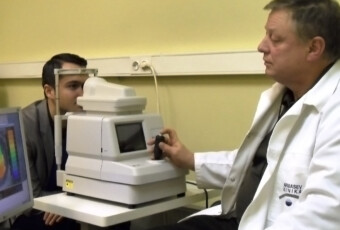
 show All photos
show All photos
